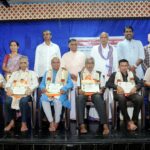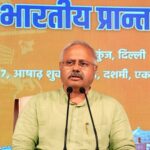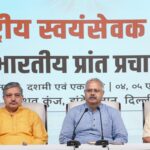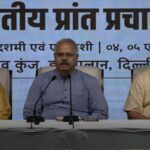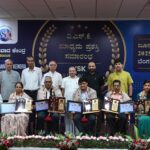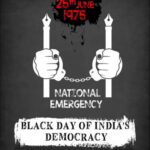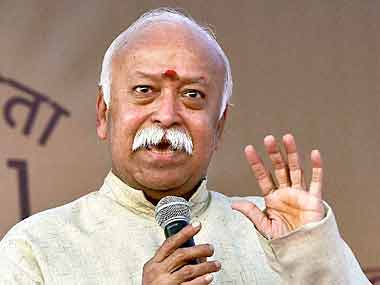
Dr Mohan Bhagwat
‘Social Equality is a Matter of Conviction’: Interview of RSS Sarasanghachalak Mohan Bhagwat to Organiser and Panchajanya.

RSS Sarsanghachalak Dr Mohan Bhagwat with his call for ‘One Temple, One Cremation Ground and One Water-body’ for all in a non-discriminatory way has provided a new action programme for social equality and harmony. Many outside the RSS circles are also appreciating the initiative. The third Sarsanghachalak of RSS, Shri Balasaheb Deoras provided momentum to the social thrust to this reformist thinking, which now Shri Mohan Bhagwat is carrying forward. On the sidelines of the RSS Akhil Bharatiya Pratinidhi Sabha held at Coimbatore, Tamil Nadu, Organiser Editor Prafulla Ketkar and Panchjanya Editor Hitesh Shankar spoke to him on Balasaheb Deoras, his contribution to Samrasata and the way ahead.
Excerpts:
Since 1925 itself, Samrasata has been in the basic nature of RSS. Later, Balasaheb Deoras was a great inspiration in this endeavour. How do you look at his contribution?
The organisation of Hindu society is impossible without Samarasata (social harmony). Therefore, non-discriminatory approach is mandatory for unifying the Hindu society and this has been there in the RSS since its inception. However, the strength of RSS has increased over a period of time. In the RSS, Samarasata has been in practice since its formation. But when Balasaheb took over as the Sarasanghachalak, the atmosphere in the society started becoming conducive for listening to what RSS says, to think over it and to experiment over it, at least to some extent. Today, the influence of RSS is much higher, then it was not that great, but it was just a beginning. This egalitarian approach of RSS was necessary for the society as well. Therefore, after assuming the responsibility of Sarsanghachalak, Balasaheb unequivocally declared about the ‘social thrust’ as the main objective of the organisation. To make the meaning of this clear to the Swayamsevaks and also to the society at large, Balasaheb deliberately prepared for months together and delivered his famous address in the Vasant Vyakhyanmala (a lecture series organised at Pune on May 8, 1974). The practice was prevalent within the Sangh but the thought process behind this was made clear to the Swayamsevaks through that address and a message was delivered to the larger society as well.
What was the impact of this insistence on Samarasata by Sangh on the society?
Sangh’s belief in Hindutva is a well-known fact. What would be the Sangh’s approach towards the caste system that is predictably associated with the term ‘Hindu’? There were well-intended people in the society who believed that this organisation must be in support of the caste system or caste-based discrimination. Then, this issue was publically discussed about the Sangh. This perception was there and there were many people who used this to unfairly target the RSS. But when Balasaheb categorically said that the ‘untouchability should be thrown lock, stock and barrel’, these discussions immediately came to an end. With this, Swayamesevaks also garnered courage to present their position in the society. The Samrasata was there in practice but common Swayamsevaks were not aware about the ideological edifice of those actions. Balasaheb’s speech unfolded all this, the thinking and the corresponding steps, clear for the Swayamsevaks. They also became more confident about their position in the society. The suspicion of the genuine people in the society was removed with this clear position. This facilitated many things. There are many instances where RSS Swayamsevaks stood by the
victims of discrimination when many in the society were not ready to take a clear position.
After the historical speech of Balasaheb Deoras at Vasant Vyakhyanmala which new dimensions were added to the Sangh work?
Naturally, many new dimensions were added with the beginning of work with the society. The churning started about what are the problems of these groups who are victims of social discrimination, what do they think and what are the remedies to bridge the huge gap that has emerged in the society. In the same process initiative of Samajik Samrasata Manch was started. Special efforts were made to establish contact with different social groups and bring them to RSS Shakha activity; especially the social groups that were psychologically uncomfortable in calling themselves as Hindus due to discriminatory practices were focussed on. Resultantly, the strength of Hindu organisation was added to the larger struggle for self-respect by various groups.
What measures would you suggest to eradicate the social discrimination?
The first and foremost remedy is a continuous process in which we should learn to completely reject all kinds of discriminations in our personal, family, professional and social behaviour. We will have to change our habits for that. For instance, there are many proverbs that are still in usage. Many a times we use it not to demean certain communities but it hurts the people who are the victims of discrimination. We will have to consciously get rid of such usages and habits. Sometimes, though we are mentally and morally convinced about principle of equality, some of our habits do not allow us to act accordingly. We will have to change such habits. Whether we have really discarded the discriminatory practices and inculcated the egalitarian values will be tested again and again, particularly, by our own people with whom we want to connect with for building a non-discriminatory and harmonious society. Even in our normal behaviour such values will have to be nurtured. For instance, I went to somebody’s place. I am not thirsty, still water was offered and I did not have water, this action of mine can also create doubt about my intent of not having water, even though I did not mean anything. Shri Guruji once set an excellent example through his action. A Swayamsevak invited Shri Guruji for a cup of tea. He used to stay in a small hut, in a condition of absolute poverty. When Guruji went there, couple of karyakartas accompanied him. The place was so small that one could see his mother preparing tea while sitting on a chair near door. The utensils were not clean; there was no tea strainer; the tea was strained with a cloth that was also not very clean. When the tea was offered, someone said I don’t have tea, the other said I had a lot of tea since morning. Guruji happily had tea. While returning, the accompanying karyakartas asked, how could you have that tea? Shri Guruji replied, you were observing the tea, I was drinking his love and affection. Such conscious but obvious efforts are needed. The society needs love and respect. So our behaviour should be to protect the self-respect of all. We have to get habitual to this.
Secondly, many issues arise in public life, like inter-caste marriages. Those issues also face opposition. We insist that Swayamsevaks should stand in favour of such reformative measures. Generally, it happens and it should happen. If you take a survey, you will find more Swayamsevaks with inter-caste marriages than anybody else. We observe that in our personal interactions. Two messages were sent to the couple involved in the first public inter-caste marriage in Maharashtra, one was that of Dr Ambedkar and the other was by Shri Guruji. In his congratulatory message, Shri Guruji wrote that not because of physical attraction but to register a protest against the caste system, you are tying this knot through an inter-caste marriage, I support this marriage and convey my best wishes. This message was conveyed to the Swayamsevaks also.
Sangh Swayamsevaks should take such public position, without getting carried away by momentary public sentiments or self-arrogance. It is necessary that Swayamsevaks take a lead role while keeping the social unity, integrity and harmony in mind to sincerely and fearlessly carry out that role.
What are the major obstacles in the path of Samarasata?
As I said earlier, the biggest hurdle is our habits and mindset. We have been practising certain things for more than two thousand years, in which Adharma is followed in the name of Dharma. If we can’t desist our fascination for old things then by breaking it, we have to stand by truth and justice, as Balasaheb clearly said – ‘it should be thrown lock, stock and barrel’.
The issue of discrimination crops up in the form of injustice incurred by ancient Brahminical system. When our ancestors are discussed as selfish and arrogant, the first obvious reaction is to defend our forefathers. The person is actually referring to the inhuman treatment of discrimination, which he has been facing for thousands of years. Take it as his genuine anger and support his stand on equality. If your ancestors and ancient traditions are great, then they are not going to belittle by anyone’s accusations. If there is an injustice, we have to oppose it. Once a Sangh Karyakarta was asked in a programme that you revere Prabhu Shri Ram as an icon of Hindus, do you also support his slaying of Shambuka? This is a tricky question for a Hindu. It creates the dilemma of denouncing Prabhu Ram or supporting the killing of Shambuka. The RSS Karyakarta replied in a very brave and intelligent manner. He said, first of all I should congratulate you as somebody who has sent you to ask this question and you have come well prepared. Through this question you have accepted that someone with name of Ram existed in our history. This is a great thing. Now whether Ram really killed Shambuka, this is a debatable issue as many believe that this whole chapter is added in Uttar-Ramayana (later part). The Ram we worship only killed the unjust and devil king. Slaying of Shambuka is not a matter of respect for us with reference to Prabhu Ram and if it is ever proved that Ram was responsible for the killing of Shambuka, we will denounce that. This kind of clear position we should be able to take. This does not amount to the insult of our forefathers. Savarkarji used to say, do not blame the ancestors for wrong things but denounce the wrong doings of forefathers respectfully. This is very easy to say but very difficult to practise as it gives a feeling of diffidence. In such practical issues, even if our self-interest is hampered we should stand for the just and righteous cause. In this process, we many a times have to face the social reaction. We have to learn how to manage that and how to respect that. We should strive to garner enough courage to deal with such situations.
Another aspect is, we have to accept that due to the discrimination of thousands of years, there would be anger, sometimes even hatred and still we should continue to strive for building bridges. We should remain confident that after exhaling the anger, the hatred will subside. Simultaneously, there are forces who are interested in vitiating the atmosphere. This conspiracy is going on. We have to deal with them as well. Therefore, with love and care, we have to raise people in each and every community who stand for unity, integrity and harmony. This is the need of the hour and also a continuous process.
As you said, nurturing Samrasata is a continuous process. What would be the role of different sections of the society in this process?
An interesting corollary was given by Pt Deendayalji. He said, if you have to pull out someone from a pit, then it is not sufficient that he is ready to come out of it by raising his hands and lifting his foot, the person who is outside the pit also has to bend down. This process has started. The hesitance of bending down from above should go away. We should strive hard to extend our hand to the best possible extent for helping others. Secondly, we need to be calm in thinking, communication and action. Balasaheb in his speech said that untouchability and injustice is clearly visible. Ultimately, we are one society, so it is our responsibility to maintain harmony in it. We cannot persist with the conflict of perpetrators of untouchability and victims of untouchability. If we do not want to widen the rift, if we want peace and harmony, then both the sides should get rid of abusive language. One section has to realise that the anger of thousands of years is being expressed and therefore not to react with similar anger is needed. The other side should learn to tone down the language while expressing their anger for reducing the social strife and gap. We can articulate injustice in a respectful way. The leaders also use discretion for ending all kinds of injustice. A system should be developed in such a way that no one with intent of injustice can rise again. This all should be done with the objective of unifying the society. The system should have inbuilt provisions to maintain the egalitarian system, new suggestions should be accepted. By assimilating everyone in this process, if we start exhibiting this in our action, without waiting for others, then this objective would be attained earlier and faster.
What are the future plans of RSS in this process of social transformation?
The fundamental plan of Sangh is to assimilate all through sincere actions. Whatever may be the external situation, people of all sections of the society should be friendly to each other. As people from same social groups become friends, their families get connected, natural interactions begin and family level affection develops, this has to happen across the sections. Wherever such actions are taken, genuine efforts for equality should be made, we should support and strengthen them, and try making them successful and victorious. This is our work. The victims of injustice should get justice at the earliest. The practice of equality is imitated all over and there should be cordial dialogue in this direction. Therefore, undertaking surveys, talking to people on these issues, and convincing people on the same, are the new initiatives taken. Many new measures can come up in this process.
Recently you gave a call for One Temple, One Crematorium and One Water-body. What kind of response you are getting from the leaders of various sects and religions?
Almost, all responses are positive. The principle behind this call got cent per cent acceptance. But those who do not understand Sangh or oppose it for the sake of it would comment why now or would say it is too late. So the call for One Temple, One Crematorium and One Water-body was not opposed per se but a question mark was certainly put on the intention behind this. Or else they said it is merely a sloganeering. The issue was not directly opposed by anyone. On the other hand, a large section of society rejoiced at the call. The victims of discrimination certainly saw a ray of hope.
There is an incident behind this call. Before my VIjayadashmi speech in which I gave this all, I went to Palamuru in Telangana, where many Swayamsevaks are there from the so-called backward sections of the society. I was the Sarkaryavah then. A so-called Dalit leader with Left leanings was sharing the stage with me. I spoke first and then he addressed the gathering. I was supposed to speak on Samajik Samarasta (Social Harmony), which I did. After that he publically accepted that I thought RSS to be a caste-ridden organisation but what I am seeing here is Sangh is full of our own people and some of them are full-timers. I just listened to the RSS General Secretary, and could not believe that the Sangh could publically take such a stand. He asked whether this is a genuine position of RSS. After his speech, in an informal discussion, I assured him that this is what Sangh believes in. It is a matter of conviction for us. He was surprised with that. After that we remained in touch. He interacted regularly with the local level office bearers, sometimes even communicated with them. In one of such discussion, I said the issue of temple, crematorium and waterbody should go first in the society as these are the issues of day-to-day experience. He said, you will not say this publically. I said, I am going to say this, you attend the Vijayadashmi function to listen to this. He actually visited Nagpur to see whether I actually took this position or not. Now he himself speaks among his community leaders about this position of Sangh. He advises them not to keep RSS people away. Such kind of leadership, not embroiled in political interests and still really represent the so-called Dalits, would certainly be happy about such initiatives. They would be positive about Sangh. The message will be conveyed to the whole nation.
How far politically favourable atmosphere helps in furthering this cause of Samarasta?
Politically favourable atmosphere can be helpful only in one sense, if people in politics decide to do so. Wherever people in favour of social equality are in power, there they ensure the strict implementation of the Constitutional and other legal provisions pertaining to the Scheduled Castes and Scheduled Tribes. Even if the government ensures the timely allocation of funds and appointing the right person for the right job, that itself would be a big job. Fifty percent of systemic issues would be resolved by this. These provisions are already there, we just have to implement them in right spirit. We believe that wherever Swayamesevaks are in government positions, they should focus on this aspect. We can only insist on this and we are doing this sincerely.
What can be the role models for creating Samaras (harmonious) and integral society? What can be the inspiration for the same?
The real inspiration is in our culture itself – truth, compassion, purity and austerity are four pillars of Dharma. What is the Truth? The truth is our biggest conviction that the same eternal principle exists in everyone and everyone is the manifestation of that. Nobody is big or small, ours or aliens. All are ours. The obvious corollary of this is to be compassionate to all. Dharma, means the principles that hold the society, it starts with the two principles, all are mine and I am there in others. Therefore there should not be any degeneration in the system. This compassion comes from the feeling of affinity. If such person is pure, without any self-interest, then he would surely dedicate his life to the public good. Such a life would take him to the path of Dharma.
Therefore, Dharma, the four principles that hold our society is the crux of our culture. All our religious texts, whether, Bhagwadgeeta, Shri Bhagwat Puran, Shiv Puran or the message of Tathagat Bhagwan Buddha, convey us the same thing. All our Bharatiya traditions, may be having different paths, may be having differences on primacy of matter or spirit but their instructions for our actual behaviour are the same. It is not there only in a written form. Thousands of Saintly people actually led that life. This is not only true with the ancient Saints but with modern monks. Swamy Vivekananda celebrated the festival of feeding labourers working in the Varahanagar Muth. Service to man is service to God was the message he conveyed to all. To experience the pain of being an untouchable, Gadage Baba, a modern Saint in Maharashtra used to go to roadside water well and ask for drinking water. He used to fetch water himself on the instruction of the farmer. When suddenly he use to ask about his caste and he would not tell his caste and experience the literal lashes. Dr Ambedkar himself did that many a times. So we have such lives to follow even in modern times that made great sacrifices for the cause of social harmony. This is a great inspiration in itself. This is my society and my nation is the biggest inspiration one can have. If my own people are living in a despicable condition then what is the use of my name and fame. If I travel around the world, then the issue of caste-based discrimination would be a matter of shame and not pride. Devotion towards society, nation and culture is a significant force which we should create amongst all.
Inherent Unity in diversity is the biggest strength of the Hindu society. Why there is a competition to create divisions in it?
The main reason of such divisions is forgetting the nature of one’s true self. Once I consider a section of my society as enemy, then to protect my own interest I would oppose you at any cost. There are examples of inviting even enemies of the nation for protecting selfish interests. Dr Babasaheb Ambedkar during the
deliberations in the Constituent Assembly, warned against the same. He categorically said that no foreigner could win over Bharat on his own strength. We lost because of our divisions and some people betrayed our own nation. This has been part of our history, which should not be repeated.
Therefore, we have to revive the basic principles of unity. There are many forces which are working to widen this gulf of divisions for self-interests. Instead of fighting against such forces time and again, it is better we strengthen our unifying tendencies and act accordingly.
You travel throughout the nation; you have been reiterating this subject of Samarasata time and again. How do you see the end-result of this?
See, insisting on Samarasata and inspiring the actions based on this in all aspects is necessary and we are trying to do the same. I am sure, one day this would bear the fruits and whole society will accept this. The divisive tendencies are counting their days. There are few people who are making necessary corrections and trying to follow the path of Samrasta. The larger section of society generally follow the trend. We have to strengthen the voice of righteousness, the society will follow it. Babasaheb used to say that numerous efforts are being made to create a discrimination-free, egalitarian and exploitation-free society. Many people have sacrificed their lives. I sincerely feel that we will get the cumulative result of all those efforts and soon we will have a discrimination-free society.
